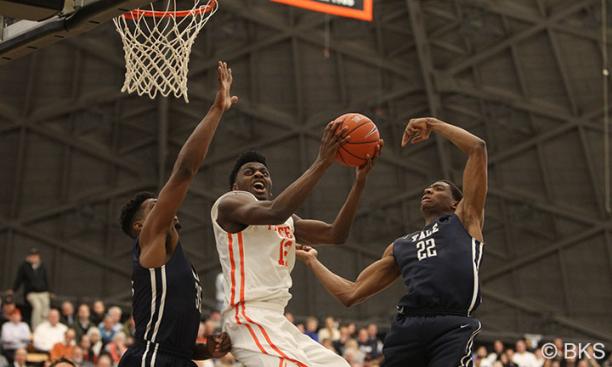
The Ivy League announced Thursday that it will institute a postseason tournament for men’s and women’s basketball next season, which will determine who earns the automatic bid to the NCAA Tournament. The playoff will feature the top four teams in each league, and the inaugural event will be held at The Palestra at Penn. It marks the end of an era for the Ancient Eight, which was famously the nation’s only conference without a tournament for nearly two decades.
Until now, the Ivy’s NCAA Tournament slots have gone to its regular-season champions, with a playoff to break ties if necessary. (Yale’s men and Penn’s women won their respective bids this year.) That system has treated the Tigers very well: Princeton’s men went to 22 NCAA tournaments by winning the conference, while the women’s team has done so in five of the last seven years.
The proverbial “14-Game Tournament” is all Ivy fans have ever known, and it’s sad to lose a unique tradition. But here’s why you shouldn’t fear the conference tournament:
Good teams will still represent the Ivies in March Madness. The canonical argument against a tournament is that smaller leagues should be represented by the team most likely to succeed in the Big Dance. It’s true that the best team is more likely to win over a two-month season than a one-weekend playoff — but the difference is surprisingly small. Research by college basketball savant Ken Pomeroy and Ivy League analyst Michael James have shown that the best team is roughly 10-20 percent less likely to win a conference tournament than a full season. That’s a real downside, but not a massive one.
It’s especially small in today’s Ivy League. A decade or two ago, Princeton and Penn stood head and shoulders above their peers, combining to win 19 straight men’s regular-season titles. In that era, a conference tournament upset could have sent a vastly inferior team to get blown out as a 16-seed. But there’s much more parity in the modern Ancient Eight, and the four-team format means almost every qualifier will be good.
Take this year’s standings: The 3-seed in a hypothetical tournament, Columbia, was picked as the league’s top team by many before the season, and its potent, experienced offense would frighten any major-conference Goliath. Fourth-place Harvard played No. 1-ranked Kansas to a draw through 32 minutes this year. On the women’s side, the Ivy has been a top-10 league by RPI for two straight seasons, as teams like Penn, Harvard and Cornell are catching up to the Tigers’ success.
In some cases, the conference champion will make the NCAA Tournament as an at-large selection anyway, meaning a playoff upset could give the Ivy two bids. Three recent regular-season men’s champions earned 12-seeds, suggesting they would have been in serious at-large discussion (Cornell ’10, Harvard ’12, Harvard ’14). And on the women’s side, Princeton received a nine-seed or better in three of the last five years, clearly good enough for inclusion even with a conference tournament loss.
Two bids is the best-case scenario for the league — twice as many players get the thrill of playing in an NCAA Tournament, twice as many fan bases get to pencil their own team into brackets — and a conference tournament makes it much more likely.
Regular-season games will still be intense. In the spring of 2012, the men’s lacrosse team was one game ahead of Cornell when it hosted the Big Red in the regular-season finale. Three years earlier, an automatic bid to the NCAA tournament would have been on the line; instead, it would be determined by the following week’s Ivy Tournament (which was created in 2010). But that game was still far from “meaningless” — over 4,000 fans packed Class of 1952 Stadium, enthusiastically celebrating a Princeton victory.
That’s admittedly not a perfect comparison to basketball; Ancient Eight teams get at-large bids to the NCAA lacrosse tournament much more frequently, and home-field advantage for the Ivy playoff was at stake. But those weren’t top of mind for the Tigers: The first words out of head coach Chris Bates’ mouth referenced the outright Ivy title, and players posed for pictures with the trophy.
Regardless of whether or not it leads directly to the NCAA tournament, players and coaches will still care deeply about winning the Ivy title — and fans should as well. (Princeton fans, in particular, still have important bragging rights to defendover their southwestern neighbors.) Even if less is riding on the outcome of the regular season, those games will still be intense and enjoyable.
The tournament will be really, really fun. Twice in the last six seasons, the Ivy’s NCAA bid has been determined by a winner-take-all postseason game. Both times, the experience was amazing from start to finish. In 2011, Princeton and Harvard brought boisterous crowds to New Haven, with students screaming at each other from adjacent sections until Doug Davis ’12 hit a game-winning shot at the buzzer. In 2015, the historic Palestra hosted a large contingent of Harvard and Yale fans, and the Crimson won in the final seconds.
Now we’ll get three games like that every year. Imagine a third Princeton-Columbia matchup this weekend, with the winner likely playing Yale in a do-or-die final. That would be super fun!
There were also good reasons to oppose a conference tournament: The old system rewarded consistent play over two months, it made national media care more about Ivy games in January and February, and it gave us some terrific regular-season finishes. But now that the tournament is here, it’s time to embrace it.
Kevin Whitaker ’13, a former PAW student columnist and Daily Princetonian sports editor, covers the Ivy League for Big Apple Buckets.
